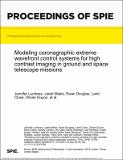Modeling coronagraphic extreme wavefront control systems for high contrast imaging in ground and space telescope missions
Author(s)
Lumbres, Jennifer; Males, Jared R.; Douglas, Ewan S.; Close, Laird M.; Cahoy, Kerri L.; Carlton, Ashley K.; Clark, James; Doelman, David S.; Feinberg, Lee D.; Guyon, Olivier; Knight, Justin; Marlow, Weston; Miller, Kelsey L.; Morzinski, Katie M.; Por, Emiel H.; Rodack, Alexander T.; Schatz, Lauren; Snik, Frans; Van Gorkom, Kyle; Wilby, Michael J.; ... Show more Show less
DownloadPublished version (1.234Mb)
Publisher Policy
Publisher Policy
Article is made available in accordance with the publisher's policy and may be subject to US copyright law. Please refer to the publisher's site for terms of use.
Terms of use
Metadata
Show full item recordAbstract
© 2018 SPIE. The challenges of high contrast imaging (HCI) for detecting exoplanets for both ground and space applications can be met with extreme adaptive optics (ExAO), a high-order adaptive optics system that performs wavefront sensing (WFS) and correction at high speed. We describe 2 ExAO optical system designs, one each for ground- based telescopes and space-based missions, and examine them using the angular spectrum Fresnel propagation module within the Physical Optics Propagation in Python (POPPY) package. We present an end-to-end (E2E) simulation of the MagAO-X instrument, an ExAO system capable of delivering 6x10 -5 visible-light raw contrast for static, noncommon path aberrations without atmosphere. We present an E2E simulation of a laser guidestar (LGS) companion spacecraft testbed demonstration, which uses a remote beacon to increase the signal available for WFS and control of the primary aperture segments of a future large space telescope, providing of order 10 factor improvement for relaxing observatory stability requirements.
Date issued
2018-07-18Department
Massachusetts Institute of Technology. Department of Aeronautics and AstronauticsPublisher
SPIE
Citation
Lumbres, Jennifer, Males, Jared R., Douglas, Ewan S., Close, Laird M., Cahoy, Kerri L. et al. 2018. "Modeling coronagraphic extreme wavefront control systems for high contrast imaging in ground and space telescope missions."
Version: Final published version